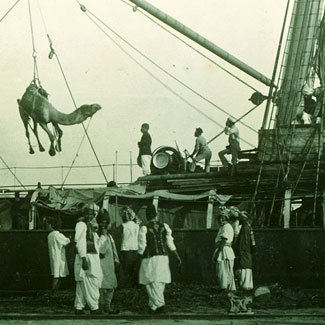History of Australia’s Muslim cameleers

MORE THAN ONE MILLION feral dromedary camels are wandering around the Australian outback, stripping vegetation and knocking down fences. They’re viewed as pests, and there are plans to cull them. But their ability to flourish in some of the harshest, driest conditions in the world was the very reason their ancestors were brought here.
From the 1860s to the 1920s, an estimated 20,000 camels and more than 2000 cameleers – men skilled in handling them – were shipped to Australia from Afghanistan and Pakistan, according to a new exhibition at the Immigration Museum in Melbourne.
Unlike horses and bullocks, the camels could trek long distances without food and water, which made them indispensable for exploration. “The cameleers played a key role in many of the exploring expeditions,” said Philip Jones, curator of the exhibition. “They opened up the interior.”
Burke and Wills expedition
Following a few small-scale exploration successes with camels in the late 1850s, the Victorian Expedition Committee in 1859 commissioned a local businessman who exported to India to buy camels and recruit cameleers. On 9 June 1860, 24 camels and three cameleers arrived at Port Melbourne, to join the pioneering Burke and Wills expedition.

Unloading camels, Port Augusta, 1890s.
While the expedition successfully made it from the south coast to the north, through the heart of Australia, Burke, Wills and others lost their lives on the return journey. “Disastrous as it was, it was quite certain that Burke, Wills and King could not have made the north-south continental crossing without camels,” Jones says.
By the late 1860s, camels and cameleers were arriving regularly. The men signed three-year contracts. In return for their meagre pay, they made a vital contribution to the history of Australia – one which has largely been left out of the history books, says Cara Rosehope, an amateur historian in Melbourne. Cara’s great-great grandfather was a cameleer who married an Australian and stayed in the country.
Camel way or the highway
“Until the arrival of motorised transport in the interior, in the early 1920s, there were only camels. It was the only way to get across great stretches of land.”
As well as being used for exploration, the camels were indispensable for the development of central Australia. Their keepers walking beside them, they carted food and water to gold mines, and took produce to the railheads. They were also crucial to the construction of the Overland Telegraph, and carried wire for the rabbit-proof fences.
“The expression ‘Australia rides on the sheep’s back’, which was current during the early 20th century, was probably due to the camel’s back, and to the men who had the skills to manage and load the camel,” Jones says.
Australia’s Muslim Cameleers: Pioneers of the Inland 1860s to 1930s is at the Immigration Museum at 400 Flinders Street, Melbourne, from 26 February to 19 September 2010.
LINKS
Immigration Museum
Muslim Journeys, National Archives of Australia




